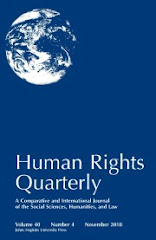This article puts forward two interdependent conceptual reforms at the intersection of state torture, visuality, and law. First, to qualify as good evidence - legally and socially - torture images are usually required to be “accurate” and “transparent,” to successfully suppress all traces of the mediation and representation at work. However, this article suggests that this prevalent visual-evidentiary paradigm unwittingly serves state attempts to downplay, decontextualize, deny, and disregard torture allegations. In this light, drawing on the interdisciplinary field of visual studies, this article re-envisages the limitations as well as the critical potential of torture images.
Second, international and domestic law tend to conceptualize state torture in exclusively physical and mental terms. Challenging this tendency, this article argues that the extreme gravity of the physical and mental violence of torture ought not obscure, and in fact warrants closer attention to two other, interrelated forms of violence through which state torture operates, acquires its meaning, is experienced, and is made possible: (a) the violence of state mechanisms of (in)visibility - representational violence - which includes state efforts to control by whom and to what degree state torture can be seen; and (b) the violence of law - legal violence - which manifests itself in the contribution of legal institutions, lawyers, and legal rhetoric to enabling, legitimating, and keeping state torture out of public sight.
The perspective of this article is transnational, focusing on three cases of state torture: detainees in U.S. custody overseas; Palestinian detainees in Israeli custody; and opposition group members detained in Syria. Legal examples and visual materials from these three cases provide a contextualized basis for exploring what new light the proposed conceptual reforms can shed on the socio-political complexities and consequences of state torture.
Thursday, August 21, 2014
Viterbo: Seeing Torture Anew: A Transnational Reconceptualization of State Torture and Visual Evidence
Hedi Viterbo (SOAS, University of London) has posted Seeing Torture Anew: A Transnational Reconceptualization of State Torture and Visual Evidence (Stanford Journal of International Law, Vol. 50, no. 2, pp. 281-317, 2014). Here's the abstract:





